How to Spot the Common Signs of Needed Roof Repairs
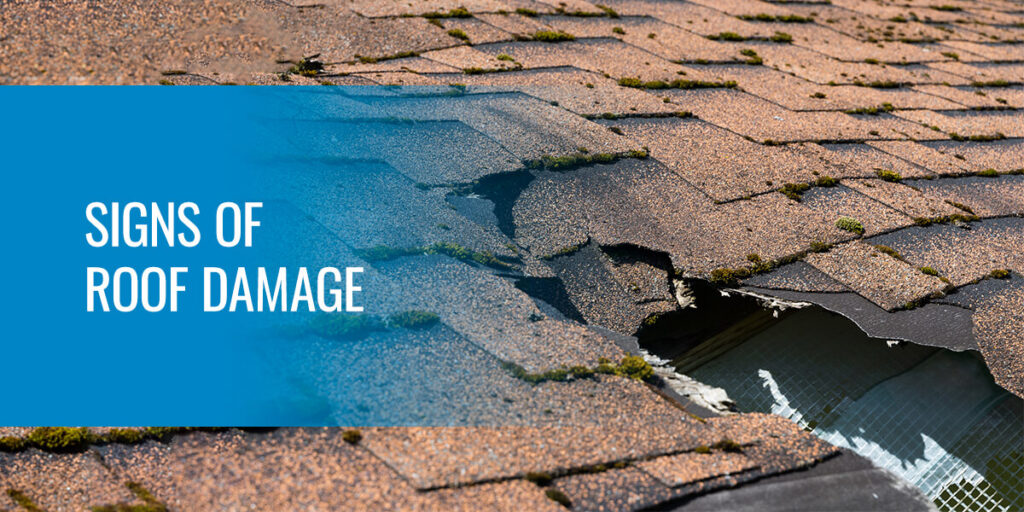
With so much going on in your busy life, it’s easy to forget about your roof. While roofs are built to withstand years of wear and tear, a rogue storm or a similar event can lead to problems. Some issues, like signs of hail damage on roofs, can be hard to spot, especially if you don’t know what to look for. Missed signs of roof damage can lead to expensive repairs or replacements down the road, so staying on top of your roof’s condition is essential.
Understanding how to spot the signs of storm, wind and water damage on roofs will help keep your home secure and safe all year. In this guide, you’ll learn to recognize the exterior and interior signs of roof damage and what to do when you find a problem. Don’t get caught off guard by a damaged roof — protect your home and save money with the help of this article.
Exteriors Signs of Roof Damage
Exterior damage is often easier to spot than interior damage, especially if it’s moderate to severe. More minor signs of roof damage might be difficult to spot, but you can survey your roof from the ground with binoculars or from a ladder to check for problems. Roof damage can creep up on you, which is why it’s essential to perform regular visual inspections.
Watch for some of these signs of exterior wear when inspecting your roof:
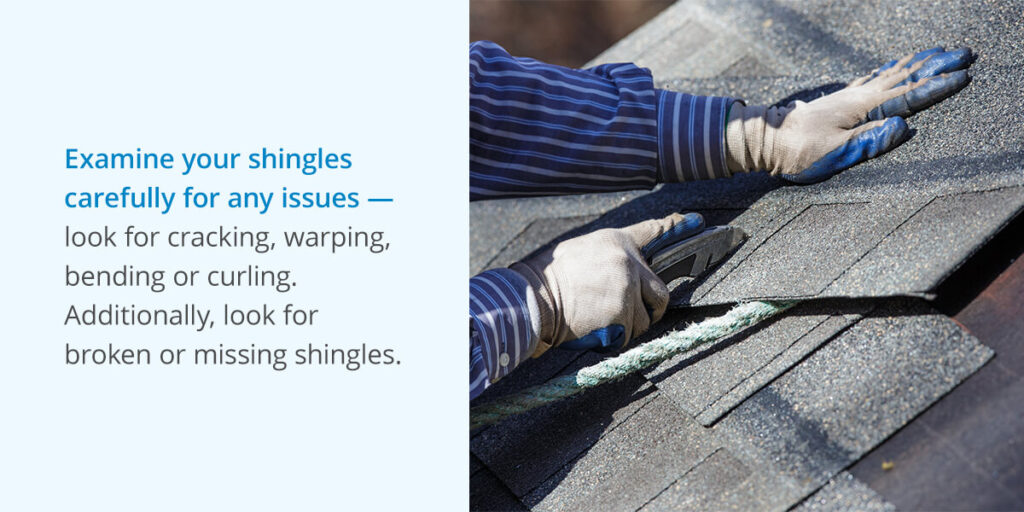
1. Shingles
A roof’s shingles are vital for providing water resistance and protecting against the elements. Any problems with your roof’s shingles could lead to water damage.
Examine your shingles carefully for any issues — look for cracking, warping, bending or curling. Additionally, look for broken or missing shingles. Any damaged singles need to be replaced as soon as possible. Compromised shingles mean your roof isn’t as waterproof as it should be, so call a professional for repairs if you notice any.
2. Gutters
If you have clogged or damaged gutters, you could end up dealing with water problems in the future. These systems redirect water off of your roof and away from your home, preventing it from sitting and causing serious moisture issues.
Check out your gutters, especially after a storm, to ensure they’re clear of any leaves, buildup or debris. It’s normal to get blockages and accumulation in your gutters — just be sure to clean them out regularly to stop water from flowing back onto your roof.
3. Hail Damage
Even mild hailstorms can inflict damage to your roof. Small balls of ice could harm your car, windows and roof, so always check your roof out once a hail storm has passed.
Some signs of hail damage on your roof include:
- Split shingles
- Indents and divots
- Loss of granules
- Dents in metal flashing
Due to the color of your shingles and hail’s relatively small size, you might overlook the extent of the damage after a hailstorm. If you can’t spot any subtle dents and splits in your shingles or roof material but the storm was severe, contact a professional for an inspection. A roofer can get close to your roof and locate problems.
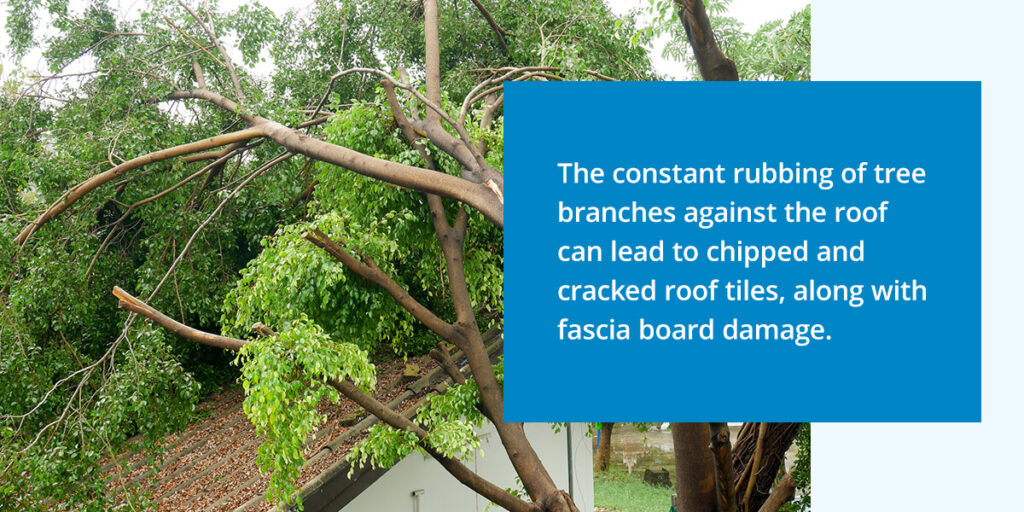
4. Tree Branches
If you notice branches on your roof after a storm, it could be one of the signs of wind damage on your roof. Wind can knock branches off trees, throwing them onto your roof and leading to holes, leaks and missing shingles. The longer a tree branch sits on your roof, the more extensive the damage can become.
It’s not just loose branches you have to watch out for — if you have trees touching your house, they could wear away at your roof over time. The constant rubbing of tree branches against the roof can lead to chipped and cracked roof tiles, along with fascia board damage. Nearby trees might also fall onto your roof during a storm, especially if they’re old and dying.
Make sure your roof is clear of any tree branches and nearby trees sit away from your home to help keep it in good condition.
5. Flashing
A roof’s flashing is another spot that will show exterior damage. Roof flashing is a layer of thin metal that’s usually installed around chimneys, valleys, vents, skylight windows or walls. These spots easily collect water, which would otherwise pool in their crevasses and cause problems for you without flashing. With flashing, the water rolls down toward the gutters and away from these weak points, protecting your home.
Due to many outdoor factors, flashing can corrode, rust and curl over time. If you see any of these issues on your roof’s flashing or notice the flashing isn’t intact or is missing, you need to have it repaired. These problems can weaken and harm your flashing, letting water into the weak points of your roof and creating damage.
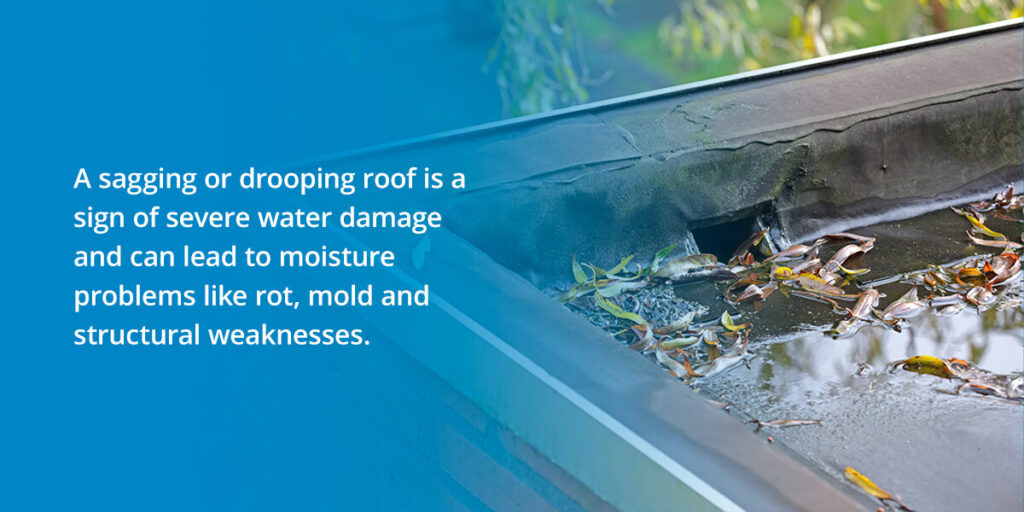
6. Sagging
A sagging or drooping roof is a sign of severe water damage and can lead to moisture problems like rot, mold and structural weaknesses. If you notice any sagging on your roof, you should immediately contact a roofer to get your roof repaired.
7. Vegetation
An increase in vegetation like moss on your roof can signify roof damage. While some moss and plant growth is expected, excessive greenery growing on your roof might mean you have a water problem. Moss and lichen can pry up shingles, letting water seep into the roof decking and beyond.
Look in your attic for signs of leaks that indicate water damage. You can also get your roof regularly power washed or cleaned to help avoid vegetation issues. If you notice the signs of water collection or damage, call a professional for an inspection to ensure the damage isn’t deeper than you think.
Interior Signs of Roof Damage
Interior signs might be slightly more challenging to spot than exterior issues. Because there can be several layers of roof and house material between you and the problem spot, it can take longer to see the damage.
Still, you should regularly inspect your roof interior to check for any issues. Additionally, you should carefully examine your roof’s interior after storms and harsh weather to ensure everything is still water-tight and protected.
Let’s look at some signs of potential interior damage:

1. Leaks
Leaks are a big sign you’ve got roof damage. This issue is a potential sign of storm damage on your roof and may indicate your roof has an age- or wear-related issue. Look for small drips and moisture spots on nails, floors and crevices. Leaks are especially common in the winter when snow can build up on your roof, so check your attic after a heavy snowstorm for any signs of leakage.
2. Sunlight
Roofs are meant to be airtight against elements, so if you see sunlight in your attic and ceiling, you’ve got a roof problem. Look carefully at your roof interior during the bright parts of the day for tiny sunbeams. If you spot any, call a roofer for assistance — seeing the sun through your ceiling means you have a hole in your roof that will need patching immediately.
3. Cracked Paint or Peeling Wallpaper
Cracked paint, peeling wallpaper or bubbling walls means there’s a water problem. As water seeps into your home’s walls, it disrupts the paint and begins unbinding it from surfaces.
If you notice issues with your wallpaper or paint, carefully feel the affected spot. Is it slightly damp? If so, you’ll need to get your roof inspected. Often, water comes in through a roof leak and travels downward, disrupting the paint and home structure as it collects inside the house.
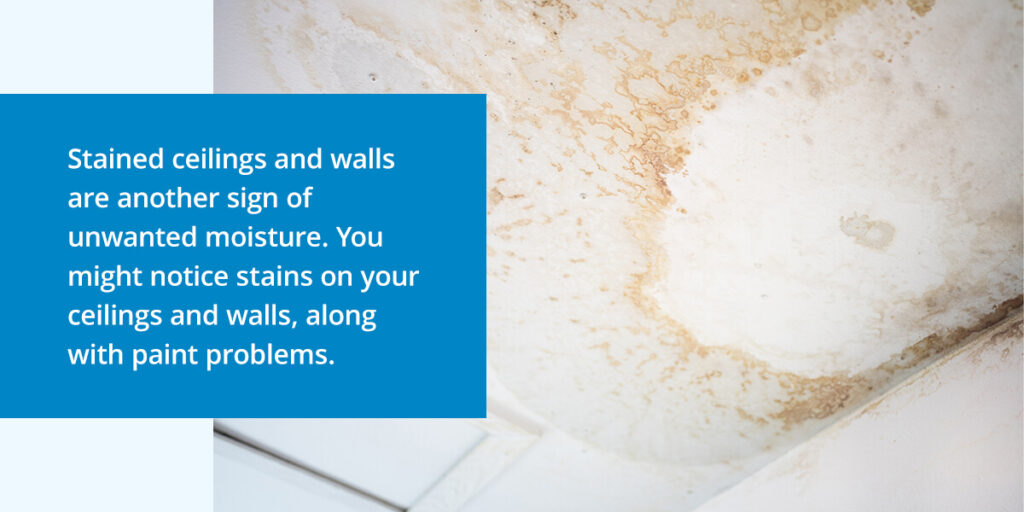
4. Stained Ceilings or Walls
Stained ceilings and walls are another sign of unwanted moisture. You might notice stains on your ceilings and walls, along with paint problems. These moisture stains mean you’ve got water coming into your house from somewhere. Any new discoloration you spot could be from a leak in your roof, so get it checked out as soon as possible.
5. Odor and Mold
Another sign of moisture is mold growth and odors. Walk around in your attic and see if everything smells normal. As water leaks in, mold and rot can begin to take hold of your structure. You might notice a new musty odor if there’s mold growth in your attic.
Mold can be dangerous, especially for people with asthma. It can trigger allergic reactions and might irritate your lungs and throat. If you spot any new brow, gray, green, yellow or black spots forming in your attic, it could be mold. Get a professional for mold removal to ensure your home is safe to live in.
6. Energy Bills
High energy bills are a good indication there’s something wrong with your home’s insulation. While you should expect to see some fluctuations as the seasons change, unusual spikes and higher-than-normal energy bills might mean you have a roof issue.
Your roof helps insulate your home, keeping the internal climate and the outdoor temperatures separate. Gaps, holes and other factors can cause your roof to not insulate everything properly. This means you’ll spend more money on energy as your heating, ventilation and air conditioning (HVAC) system tries to keep up with the rapid air loss.
Call a roofer for insulation help. You might need new or more insulation installed or there could be a roof gap letting air travel in and out. These gaps can be hard to find, so hiring a professional is essential to locate the source of the problem and fix it.
What Causes Roof Damage?
Keeping an eye out for situations that cause roof damage can help you stay on top of maintaining your home. The sooner you inspect your roof and catch a problem, the sooner you can get it repaired.
1. Wind
Wind can wear down your roof and strip its components away. It’ll tear off shingles and fling debris around, potentially harming your roof. If you’ve experienced a recent wind storm, look for some of these signs of wind damage to your roof:
- Cracked shingles
- Missing shingles
- Holes
- Bent roof edges
- Crooked chimney
- Damaged fascia or soffit
2. Water
Water is a significant cause of roof damage. You need to keep an eye out for any water damage or leaks coming from your roof. Water can easily slip through minor weakness and soon cause severe home damage, rot and mold. Wood is especially vulnerable to water damage and enough moisture exposure will seriously impact the strength of your home.
Watch out for these signs of water damage:
- Rot
- Mold
- Musty odors
- Moss and vegetation
- Ceiling and walls stains
- Cracked or bubbling paint
- Damp spots
- Roof sagging
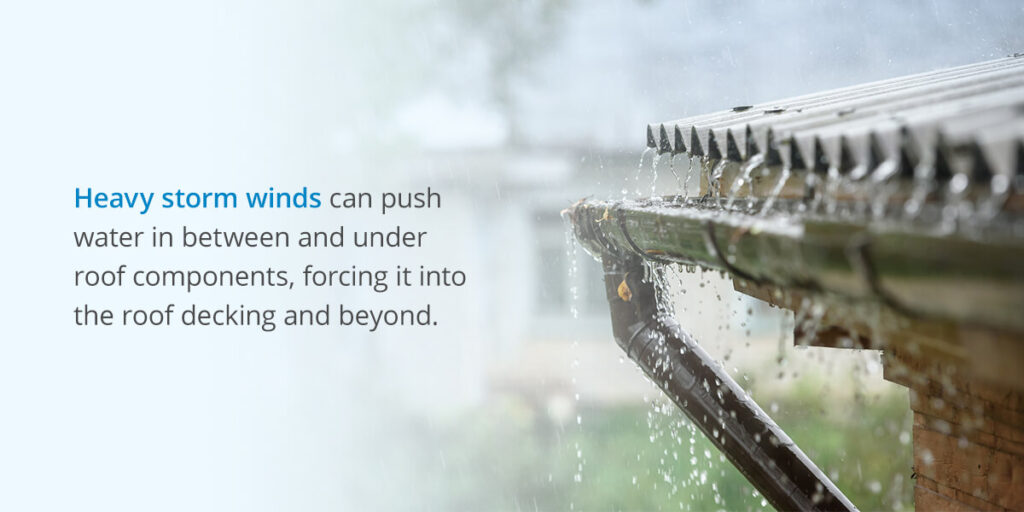
3. Storms
Storms combine water and wind, making them even more damaging to your roof. Heavy storm winds can push water in between and under roof components, forcing it into the roof decking and beyond. Check over your roof after a storm to see whether anything was broken or worn down by the harsh conditions. Coldstream Exteriors can assist with expert roof storm damage repairs in Cincinnati and St. Louis.
4. High Heat
Heat is another element you’ll have to watch out for. While roofs are meant to withstand normal temperatures, extended periods of high heat or rapidly-changing temperatures can cause problems. Heat can cause your roof to expand, leading to cracked shingles. It can also create heat blisters on shingles and damage their edges.
Heat might warp your roof, leading to a weakening of the materials. If your home experiences too many high heat fluctuations, you could end up with a split roof. These issues make the roof look worse and shorten its life span.
5. Time
Like all things, time will eventually wear away at your roof. Roofing components aren’t meant to last forever, even with proper maintenance. As your roof materials get older, you’ll have to maintain, repair and replace them.
Keep track of when your roof was installed — this will tell you when you should start looking at a roof replacement. Shingles, gutters and other roof parts can all be repaired and updated without a full roof replacement, which will extend the life span of your roof.
6. Maintenance
Neglecting roof maintenance can speed up the wear and tear of your roof. Regular maintenance ensures everything is clean, clear and safe. It’s also the best way to catch roof damage early. Without regular maintenance, minor roof damage can become a significant problem, spreading to multiple roof sections and adding to maintenance and roof replacement costs in the future.
Maintenance keeps your roof looking good and performing as expected, extending your roof’s life and giving you a better, stronger home.

7. Installation
Like with certain other home projects, poor installation can have severe consequences for you. A poorly-installed roof won’t last as long or be as safe as a high-quality installation. Your roof might not pass inspection if you’re looking to sell it, or you could have to pay for a complete replacement much sooner than you thought due to an installation issue.
Avoid this problem by only getting reputable, professional work done on your home. This will save you money in the long run and will ensure your home is as safe as possible.
What to Do if You See Signs of Roof Damage
After carefully examining your roof, you might have found a few problems. But what do you do once you see signs of roof damage? You might think about doing repairs yourself, but this is a dangerous and challenging option. Roofing is difficult to do correctly without the proper training and experience, and you could hurt yourself or make the problem worse in the process.
Always call a professional roofing company to perform the roof work. They’ll have the training, tools and experience to complete the job safely and efficiently. However, it can be tough to know what to look for in a roofing company, especially if you’ve never had roof work done before. Always thoroughly research companies in your area and check their past work and references. You want the best service possible to ensure your roof is completely fixed after the job is done.
For minor damages that will probably just need repairing, you can contact your roofer and go about your business. If the damage is more severe, you might want to find a temporary housing situation until the problem gets fixed. Don’t wait to get any roof issues corrected — the longer damage is left unfixed, the worse it can get and the more expensive your repairs will be.
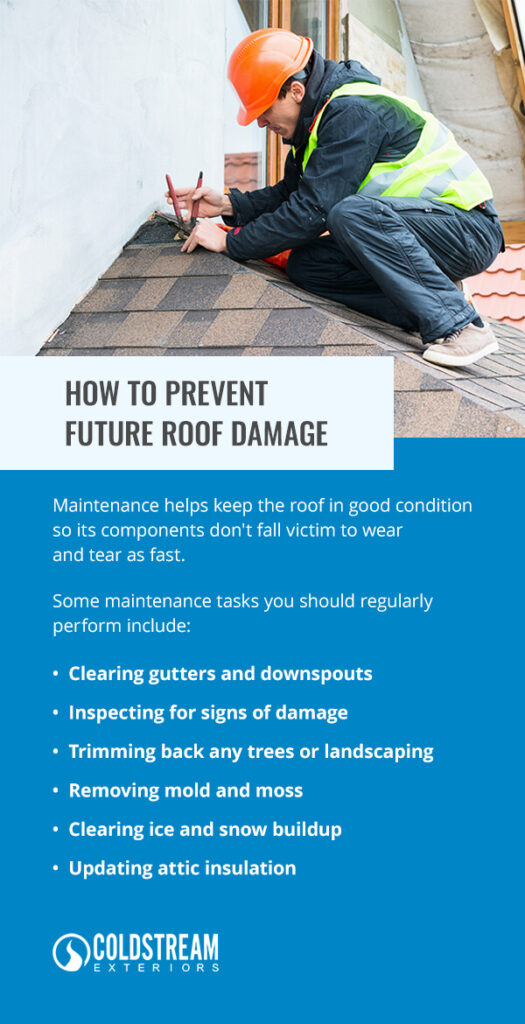
How to Prevent Future Roof Damage
Once you choose a roofing company and receive roof work, you should try to keep your roof in top condition. The last thing anyone wants after paying for roof work is to have more damage occur right after repairs. You should get your roof inspected yearly to keep it in good shape and catch any issues early on. Professional inspections will go over your roof’s exterior and interior sections so that you can maintain your peace of mind.
Roof maintenance is essential to preventing future roof damage. Maintenance helps keep the roof in good condition so its components don’t fall victim to wear and tear as fast. A well-maintained roof can last longer and look better than one that isn’t given proper care.
Some maintenance tasks you should regularly perform include:
- Clearing gutters and downspouts
- Inspecting for signs of damage
- Trimming back any trees or landscaping
- Removing mold and moss
- Clearing ice and snow buildup
- Updating attic insulation
Some of these tasks might require professional assistance, but a professional inspection will tell you what you need to watch out for. You can also get roof maintenance services, so you don’t have to worry about taking care of your roof yourself.
The most important thing is to care for your roof so that it doesn’t become worn and damaged earlier than it should. Keep your home safe with a well-maintained roof and professional inspections.

Protect Your Roof with Coldstream Exteriors
Your roof is essential to maintaining the comfort and security of your home. If you spot any signs of roof damage, getting professional roof repair is the best way to ensure your roof is restored to its best-possible condition.
Coldstream Exteriors offers roof repair and replacement services to residents in the greater Cincinnati, Tampa and St. Louis areas. With over 25 years of experience, you can trust our team to deliver superior roof work efficiently and affordably.
Rated A+ by the Better Business Bureau, Coldstream Exteriors provides high-quality, professional work and unparalleled customer services to all our clients. We’ll work with your budget to find the best financing option for you and we don’t ask for payment until the job is done, so you can be sure you’re getting the services you need.
If your roof needs repairs or replacement, contact us to schedule your free inspection today!
